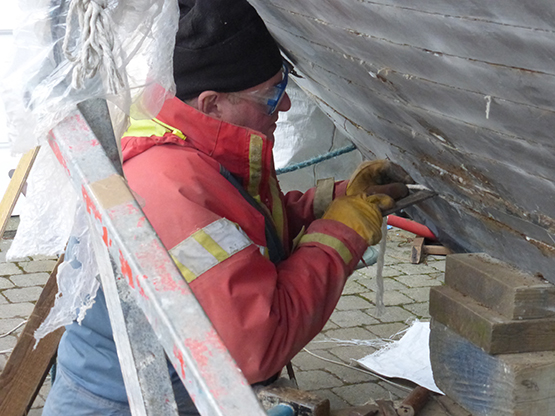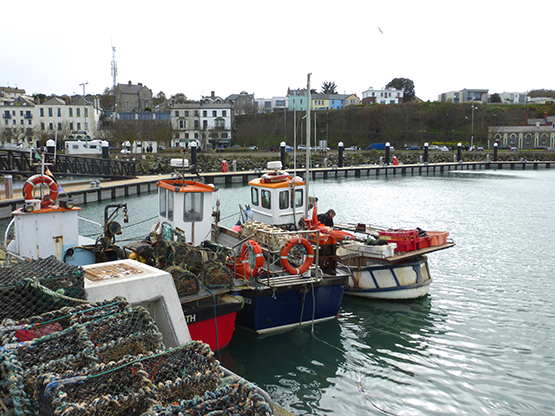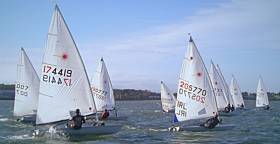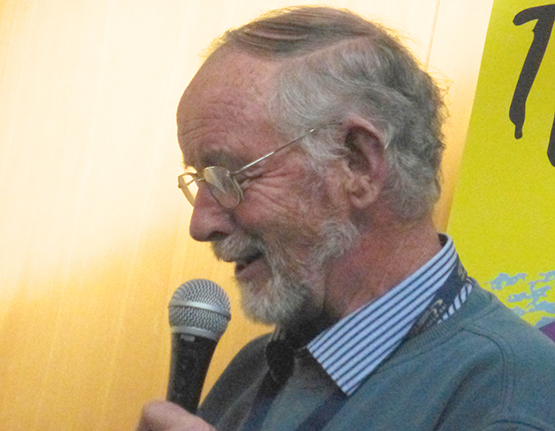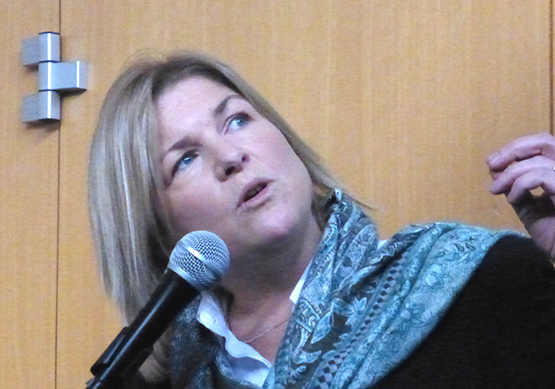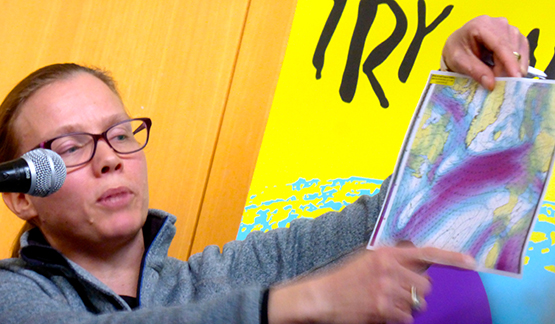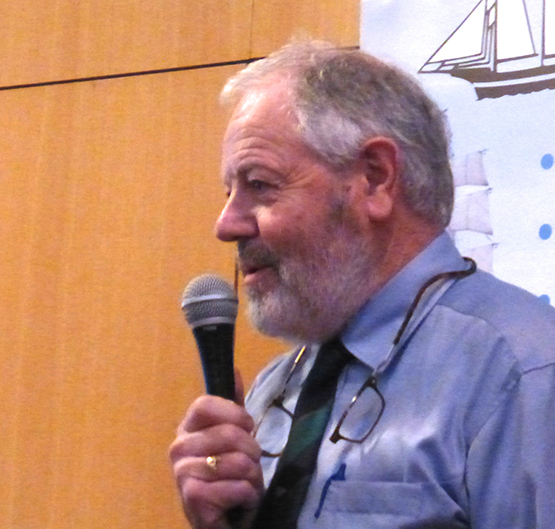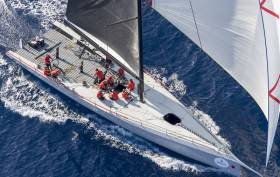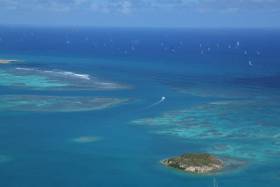Displaying items by tag: Howth Yacht Club
Howth Harbour Thoughts From Home
This weekend has the Irish Sailing Youth Pathway Championships being staged at Howth, and despite the weather the place is buzzing. From being a harbour abandoned in embarrassment for twenty years in the middle of the 19th Century, the peninsula port has gradually evolved to develop a vibrant balance between fishing harbour, sailing centre, and visitor magnet. Longtime local W M Nixon tries to tell it like it is in Howth when seen from the inside.
Howth has most of the advantages and few enough of the disadvantages of being an island. Head home eastward through the isthmus at Sutton Cross (and don’t forget you’re heading eastward - Howth is Dublin’s Eastside, while the Northside is in nearby Ireland), and you shed your Irish identity to become a Howth person. Ideally, this means you become a complete nobody among many other nobodies, for that’s the way we like it.
It must be some sort of defence mechanism, for there was a period in the middle of the 1800s when the powers that be in nearby Ireland preferred to forget our very existence. You see, when the vital links of government between Dublin and London were being maintained by special sailing packet ships, Howth was important because the island of Ireland’s Eye (even in this blog we haven’t the space to explain how it got its name), which is upwards of half a mile off the distinctly rough village, was able to provide an element of natural shelter at a time when Dublin Bay and Dublin Port tended frequently to be disaster areas for shipping.
There were times when the only shelter in Dublin Bay itself was in the very limited space inside Dalkey Island, where a sailing ship could easily be trapped, whereas Howth Sound inside Ireland’s Eye, while north of Dublin Bay and beyond the Baily, nevertheless enabled a potentially embayed ship to cut and run. And yes, that is how the phrase originated.

The north side of Dublin Bay in 1692. The Government’s cross-channel packet boats favoured the roadstead anchorage at Howth inside Ireland’s Eye as it provided better shelter than the exposed bay itself, yet there was more space to cut and run than could be found in Dalkey Sound
Thus they built an inn in the village so that people passing through to London, and waiting for the packet boat, would not impose unduly on the hospitality at Howth Castle of the St Lawrence family, unless they were awfully important. And then when the engineer Thomas Telford was commissioned to build a road linking London with Dublin through Holyhead, naturally on the Irish side he followed the official view of things and continued his road through Howth and on towards Dublin, in light of the fact that offical policy was that the Government harbour would be built at Howth.
And build it they did, from about 1807 onwards, with John Rennie in charge. But with the gathering prosperity and increased trade after the final end of the Napoleonic Wars in 1815, the movement for the improvement of Dublin port and the building of an “asylum harbour” at Dunleary within Dublin Bay gained traction, and by 1817 what would soon become the highly-fashionable Kingstown Harbour was already under construction before Howth Harbour was even properly finished.

Once the new harbour had been completed at Dunleary on the south side of Dublin Bay and re-named Kingstown, the smaller shallower harbour at Howth was forgotten about for twenty years
Nevertheless Howth continued as the official mailboat port until 1834, by which time even the most stubborn official mind had to recognise that everyone else had long since gone Southside. So at last the powers that be followed. And in doing so, they tacitly agreed that the best way to deal with the memory of the ENORMOUS expenditure of building shallow sandy Howth Harbour was to ignore the place’s very existence for as long as possible.
The local fishermen continued to use the sandy creek of Balydoyle as their main port as they’d always done, while Howth seems to have been out of bounds to just about everyone. It was declared an inviolate Royal Harbour which might be of strategic value in the event of attack by Barbary pirates or Eskimo marine commando units or whatever, and for maybe fifteen years Howth simply slumbered, quietly silting up.
But by the 1850s, the growth of the fishing industry through travelling fleets of trawlers from the great fishing ports of Devon and Cornwall and Scotland and the east coast of England meant that increasing numbers of high-powered fishing skippers, almost entirely from Britain, were demanding that they be allowed to use Howth, and by the 1860s it had been designated a “Fishing Station”.
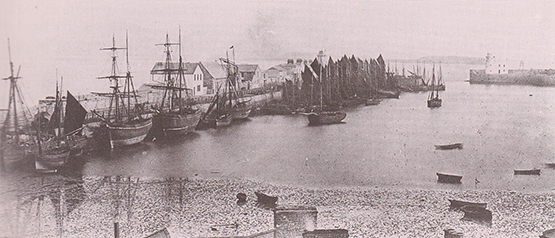
Howth Harbour in the 1870s, when it had become a “Fishing Station”
Much the same thing happened at Dunmore East, which was initially the packet boat port for Waterford, and the local fishermen weren’t really allowed into it at all. But then the advent of steamships meant the packet boats could go straight up to Waterford itself, and after an interval lying idle, Dunmore East also became a Fishing Station. But it was only because nobody else further up the pecking order had a use for it – in those days, fishermen were expected to fend for themselves.
So for thirty years and more, Howth was almost totally devoted to fishing, but in 1875 the famous Judge Boyd – he is referenced in Ulysses – took a lease on the harbourside Howth House which had originally been built as a residence for John Rennie, the engineer building the harbour. The Judge was well got, as his main house was in Merrion Square – it’s now the French Embassy – but as he was something of a maverick, he decided that he’d pursue his sport of sailing through Howth rather than Kingstown.

Judge Boyd was such a noted Dublin character that he was referenced in Joyce’s Ulysses

Thanks to Judge Boyd’s influence, Howth had a government dredger almost permanently on station from 1888 onwards. And for those who would seek further cultural references, the Yeats family lived in the house on the foreshore just to the left of the fishing boat from 1880 to 1882
A maverick he may have been, but he had influence in high places, and when the silting of Howth became even worse in the 1880s, hampering the seasonal activities of the travelling fishing fleets, the Judge saw to it that Howth got its own government dredger as an almost permanent feature.
The trouble is, the fishing was too successful – the herring were fished almost to extinction. By the 1890s, fleets visiting Howth were declining rapidly, but this in turn facilitated the development of the local sailing club, founded mostly by Judge Boyd’s sons in 1895.
However, the old Judge had lost none of his sparkle, for in 1892 he had bought the supposedly out-classed Fife 70-footer Thalia from the Clyde, and proceeded to win races left right and centre with her. Often he helmed her himself, but if he felt like a rest, the talented professional skipper who came with the boat was Owen Bissett, who stayed on in Ireland with such commitment that today one of Howth’s most able sailors, Ross McDonald, is Owen Bissett’s great-great grandson.
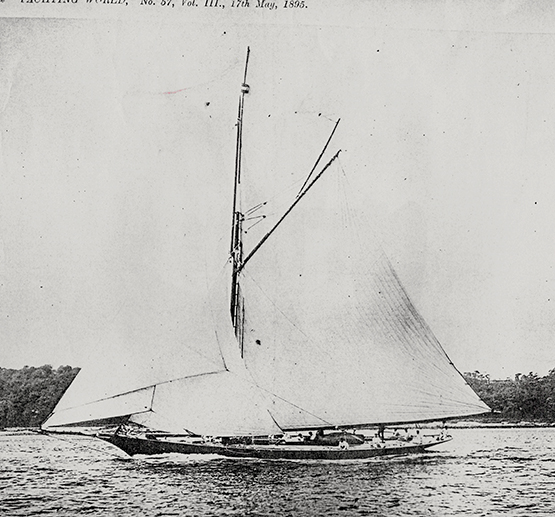
Judge Boyd’s Thalia racing in the Clyde – in Clyde Fortnight 1897 she won 140 pounds in prize money, the third highest in the regatta. Though he raced the boat himself, Judge Boyd also had a professional skipper in Owen Bissett, great great grandfather of today’s successful Howth skipper Ross McDonald
And if you wonder how the Judge managed to keep a large engineless yacht in little Howth Harbour, a yacht whose overall length from mainboom end to bowsprit end was well over a hundred feet, the answer is he treated Howth Harbour as if it was his private marina. After all, it was he who ensured it was dredged, so hadn’t he every right to keep Thalia in a very handy berth inside the nib on the West Pier? And if he happened to omit to retract Thalia’s long bowsprit which protruded well beyond the end of the nib, then heaven help any fishing skipper whose ancient craft managed to get fouled up in this exquisite piece of classic yacht equipment.

Regatta day at Howth, and Thalia in her berth inside the nib on the West Pier
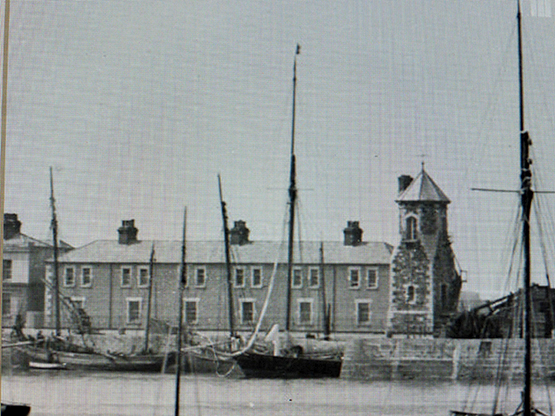
The perfect private berth – Thalia at the West Pier in Howth around 1900
It’s difficult to escape the feeling that the Judge’s four sons thought the old man was maybe a bit over the top, for in their new Howth Sailing Club they promoted the notion that “Small is Beautiful”. When the oldest brother Herbert designed the new one design class for Howth in the Autumn of 1897, the resulting Howth 17s were of very modest proportions, just 22ft 6ins in overall length.
In time, the mighty Thalia ceased to be a feature of Howth Harbour. She was of such a size that the easiest way to lay her up was a winter berth afloat in the Grand Canal basin in Dublin. But as she had been built on steel frames with copper fastenings, she was virtually on fire with electrolysis, and her days were short – by 1910 she had gone.
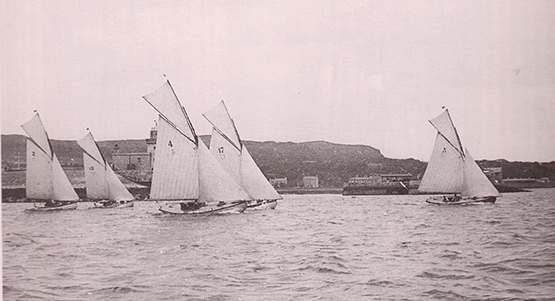
A much more modest proposition – the handy little Howth 17s were introduced in 1898, and they hope to have 18 boats racing this summer

From time to time, the Howth 17s add new boats – this is Erica and Isobel joining the fleet in 1988
The joys of classic yacht ownership…..Pat Heydon working in early March on the re-caulking of Gladys (built 1907), which he co-owns with Eddie Ferris and Ian Byrne. Photo: W M Nixon
But the Howth 17s plough steadily on 118 years later, thanks to a sort of group scheme of mutual help when a boat needs serious work done, with longtime owner Ian Malcolm as the multi-talented core of a sort of men and women’s shed movement with a maritime purpose. The purpose is to get in as much racing as they can, with as many boats as humanly possible. This season they’ll have 18 of them sailing, while a classic boat festival at Howth in early August has already roped in Mermaid Week, and they and the Seventeens will be more than happy to welcome other long-established wooden craft.
As for Howth generally, the inevitable conflict between the needs of fishing craft and the needs of recreational boating were more or less resolved back in 1982, when the recreationals were moved into the eastern part of the harbour with its marina and - in time - a completely new clubhouse, while the western section became a state-of-the-art fish dock with synchro-lift and all the trimmings.
It was a case of good fences making good neighbours, and maybe the harbour users of Howth became too contented, for the powers-that-be seemed to forget that in a harbour set beside a sandy channel through which the tide can flow with some vigour, routine maintenance includes regular dredging.
In The Netherlands, arguably the best-run maritime nation in the world, every harbour is dredged as a matter of routine every four to five years, regardless of whether or not there has been significant silting. It’s just done, and that’s how it is – it’s the Dutch way.
But in Ireland, it seems we have to chivvy the authorities to do what should be a matter of routine, and ultimately it all seems to come back to the door of the Office of Public Works, which despite its name seems to think that it’s activities should be carried out in as private a way as possible. Maybe it should be re-named the Office of Good Works By Stealth, for the word is that Howth is going to be dredged, and it might well be sooner than later.
Meanwhile, the Department of Agriculture & Fisheries have been quietly beavering away providing the small boat fishermen with their own rather splendid pontoon. It’s an extremely fine bit of work, but so far as we know, it is only recently that the notice has gone up telling us what it’s all about.
It’s coming to a harbour near you…….the notice of the new facility was erected without any fanfare...
...and for the time being there’s no news of when the new pontoon will be officially opened
As for actually getting the use of it, the situation is now a bit reminiscent of the 1840s. There’s this really classy and useful bit of infrastructure, just as there was once the unused Howth Harbour back in the 1840s. But nobody is as yet allowed near it. The smaller fishing craft still raft up outside each other, and their crews still have to clamber up the quayside.
There’s probably a perfectly good reason why the new pontoon has not yet opened for business. But as our email enquiry to the Department has gone unanswered, we can only assume that until a new Government is formed and there’s a fully-accredited new Minister ready to sweep out in the limo to perform the opening ceremony with all the attendant pomp and kudos, then this lovely pontoon will continue to float serenely on, just like the Sleeping Beauty.
While Howth’s new small fishing craft pontoon awaits its official opening, its future users continue to raft up alongside each other at the quay. Photo: W M Nixon
Howth Yacht Club Lasers Prepare for Round the Island Race
The Laser class 41st Round the Island Race from Howth Yacht Club will be contested this Saturday. The warning signal for the dinghy race is 1045. The club is going all out to swell the numbers with an offer to line up boats for sailors who may not be regular Laser sailors. The race will be followed by lunch in the HYC dining room and then prize giving.
Howth Yacht Club Laser Frostbites Decided
The 41st running of Howth Yacht Club’s Laser Frostbites came to a conclusion this morning on a cold, sunny day with a light Westerly breeze. The absence of current Laser national champion Ronan Cull, the winner of the last few series meant that somebody else was going to have an opportunity to take the event. Dan O’Connell and Daragh Sheridan stepped forward to take a series each.
O’Connell took the series before Christmas in impressive style with a string of first places and showing very impressive pace and smart sailing to clinch the nine race series. He was followed in second by Stephen Quinn who was using the impressive new radial cut full rig for the first time. Third was Mike Evans followed by Daragh Sheridan and Darrell Reamsbottom in fourth and fifth.
The second series was a mixed bag in terms of conditions starting in light wind in January and then was blown out for a lot of February. Robert Eason and Garry Sargent sailed extremely well in the light airs but their results suffered slightly in the heavier stuff later in the series. This allowed Daragh Sheridan to take the event overall with a consistent set of results in the varied conditions across the thirteen race series. Mike Evans and Robert Eason completed the podium positions with Gary Sargent and Dave Kirwan in fourth and fifth respectively.
In the Radial rigs the Winter series was won by Olympic hopeful Aoife Hopkins followed by Sarah Gallagher and R. Murdock. Sarah went one better in the Spring series to take first overall with a very strong series including a string of first places. Murdock taking second and Hopkins third.
In the 4.7 Shane O Brien won the first series from Daniel Hopkins and R. McEvoy. The order was reversed in the second series with Daniel taking first from Shane with E. Gallagher in third spot.
A special shout out to Frostbite competitor Gary Sargent who is undertaking the mammoth task of sailing a Laser around Ireland.
Next Saturday sees the annual Round the Island race with a fantastic day of sailing followed by lunch, beers and rugby on the big screens. All welcome. Entries online or on the day.
ICRA Conference Focus on 'More Sailors More Sailing'
A buoyant ICRA conference at the Castletroy Park Hotel in Limerick yesterday saw Simon McGibney of Foynes Yacht Club succeed Norbert Reilly of Howth Yacht Club as Commodore. It is the first time ICRA has elected a Commodore from the west coast.
An attendance of 80 sailors representing all the major sailing clubs on the east, south and west coasts participated for the first time in a round table format to encourage ideas from the floor on the future direction ICRA should take in order to grow the cruiser racing sector in Ireland.
In an enthusiastic gathering, Reilly summarised initiatives needed to achieve 'more sailors/more sailing' or as McGibney described it 'more bums on boats'.
John Leech gave a strong safety awareness talk and Afloat.ie's Winkie Nixon entertained with his views on ICRA's role and its positive approach to listening to its market.
Leading sailing school Alistair Rumball of the Irish National Sailing School in Dun Laoghaire and sailmaker Des McWilliam from Crosshaven made excellent presentations on their training initiates for the cruiser racing sector that are attracting increasing numbers and improving skills and feeding members to Clubs
Reilly also highlighted the ICRA crew point project which it is hoped will lead to identify areas within clubs of people who would like to go sailing and link them up with owners.
ORC gave an informative update on its developments worldwide and an insight in to its rating rule progression.
In the absense of ICRA's ECHO handicap guru, Denis Kiely, who was unable to attend for personal reasons, former commodore Barry Rose and Ronan Enright, commodore of SCORA, gave the meeting an insight in to the evolving of the system over the last seven years to a Progressive ECHO model starting from an IRC base and being totally transparent and computerised analysing performance in a measured way to re adjust ratings automatically after every race. This model has produced great results and has been used during this period at ICRA Nationals, Volvo Cork Week, Volvo DL Week, WIORA, SCORA and by clubs on the south and west coasts.
ICRA is encouraging its use nationally as it is a very effective dual scoring system alongside IRC to encourage spreading the prizes and interest through the fleet and represents a credible performance alternative to the fixed number rating systems.
Afloat.ie's Tom MacSweeney ran an inciteful interreactive session with those present on how to present a welcoming approach to encourage new entrants to the sport.
The ICRA Nationals are in Howth Yacht Club this year from 10th to 12th June and arrangements are well advanced and it promises to be another high calibre event
Volvo Cork Week, the Round Ireland race and WIORA were also promoted at the event
The Irish Sailing Association (ISA) were represented by Jack Roy and Harry Hermon and the ICRA executive are in advanced discussions with the ISA to attract the support needed to grow the sector.
The conference concluded with presentation of ICRA Boat Of The Year trophy to George Sisk and his crew on Wow who had a fantastic season winning the ICRA Nationals in the process.
ISA Cruising Conference Was On Target For Topics And Turnout
Last Saturday’s Irish Sailing Association National Cruising Conference, sponsored by Union Chandlery with full organisational support from the Cruising Association of Ireland and the enthusiastic hospitality of Howth Yacht Club, was able to put through a very complete day-long programme which covered an extraordinary variety of topics. Each area of interest was examined in detail by a leading expert – in some cases the CEO of the national agency involved – and by the end the attendees, who came from all over the country, were verging on information overload. Yet everyone finished the day well satisfied, and certainly agreed on one thing – it will be quite something to match the quality of 2016’s Cruising Conference when the next one comes round in 2018. W M Nixon was there, and though he tells us “his head was melted” with the sheer volume of the range of issues discussed and explained, he’ll do his best to let us know what happened.
It went on for seven hours and more, and ranged from the extremities of dealing with calving glaciers in Greenland at one end, to the niceties of lone male watch-keepers dealing safely and efficiently with the calls of nature in mid ocean at the other. And since you ask, there were two distinct camps for dealing with Problem B – those who favour a simple bottle, narrow enough to be stowed in a convenient winch handle holder, and those who think a yoghurt tub with its cover kept usable is your only man, as some folk need a bit of space to perform.
As for the sheer length of the programme, as a group of friends and shipmates attending together we agreed it should have been an hour shorter. But then we couldn’t think of one single item on the agenda that we would have happily discarded. So for 2018 (or next year, if the current plan to make it biennial is reckoned to be wimpishly unambitious), Paddy McGlade the ISA Board Member for Cruising, and Clifford Brown, Commodore of the Cruising Association of Ireland, will have to agree to the same densely-filled programme, and it’s beholden on the participants and the audience to be up for the challenge.
For the fact is, when you get an attendance of this calibre, you need to provide the full coverage in the programe. And if you’re providing the full service in the form of a very comprehensive conference, then you deserve the attendance of all the keenest cruising folk – or would-be cruising folk – in the entire country. And with a comprehensive turnout of 104 enthusiasts where all nvolved on either side of the programe are incuded - when they’d tried initially to keep the numbers manageably at 80 - the dynamic interaction between performers and audience was magic, and ISA President David Lovegrove was properly impressed.
ISA Cruising Convener Gail MacAllister put together a cracking programme, nicely balancing the serious issues which might have had a certain bureaucratic overtone with more overtly entertaining stuff which hit the button either by scaring us stiff, or else making us savour the pure quiet delight of a proper cruise going well with a contented crew on board.
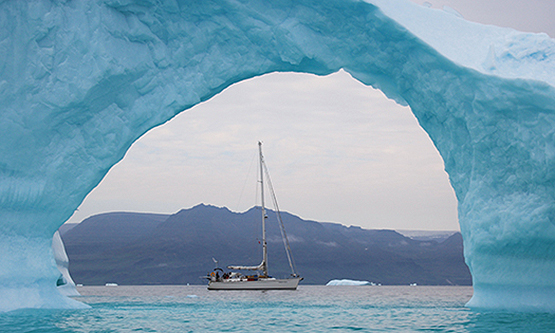
Eddie Nicholson’s Najad 440 Mollihawk’s Shadow in the frame in Greenland. The outline he gave of the pre-planning and execution with shipmates Mike Hodder and Dermot O’Morchoe of this exemplary cruise from Newfoundland eventually home to Ireland was to set the tone for the ISA Cruising Conference.
The tone was set from the start with the all-singing all-dancing account of Eddie Nicholson of Kinsale’s cruise to West Greenland and then on to Ireland from Labrador with the Najad 440 Mollihawk’s Shadow. This was much more than the narrative of an ambitious cruise. Combined with his two leading shipmates Mike Hodder and Dermot O’Morchoe, Eddie makes up a threesome of complementary talents, and their thoughtful account of what goes into planning, preparing and making such a cruise the outstanding success it clearly became was shown in the concluding informative account of what they achieved, once they’d made the effort to put everything in place.
This was obviously at the more advanced end of cruising, so as a balance we next heard from ISA Board Member Pierce Purcell of Galway, who has been on a personal crusade to fire up the interest of all recreational boat owners around Galway Bay. He runs a chandlery at Clarinbridge, and the sheer variety of people from all parts who were coming through his door in quest of maritime items large and small made him realise that his shop was a maritime focal point for the entire Galway Bay area.
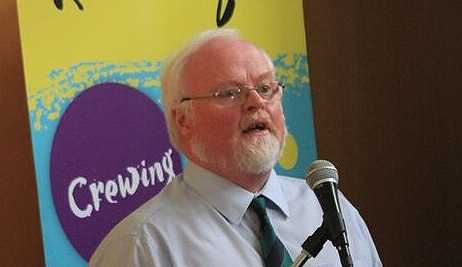
Pierce Purcell of the ISA Board outlining his innovative technique for building up a communications network of recreational boating enthusiasts around Galway Bay
So every time he sold something, he simply asked the customer if he could have their email address to keep them informed of anything that might be in the offing for boaters large and small around Galway Bay. As a result, in the last decent summer, which we had a couple of years ago if you remember, he managed to assemble a fleet of fifty-plus boats for a Bank Holiday weekend muster at Kilronan in the Aran Islands. And as a direct result of that, the WIORA Championship 2017 is going to be staged at the same venue, which will be a remarkable “first”.
The extraordinary opportunities which cruising offers for observing maritime wildlife were then outlined by Simon Berrow of the Irish Whale & Dolphin Group, and his continuing enthusiasm is at such a level that just about everyone present will be on some sort of whale watch in the season ahead.
Dr Berrow is based in Kilrush, and there’s something about the West of Ireland which sets the sailing heart afire, for we then had Daria Blackwell of Clew Bay telling us how women can get much greater enjoyment from sailing if they take steps to learn how to do it themselves, indeed the best thing is to do it well because you want to, not because some mere male needs help.

Daria Blackwell delivering the message about women adopting a more proactive role in sailing through having the most positive attitude to learning and practice. Photo: Alex Blackwell

Molly Childers on the wheel aboard Asgard in 1912. She was a much more competent helm than her husband Erskine, and it was she who made such a masterful job of steering the engine-less Asgard into Howth with a strong following wind during the gun-running episode in 1914.
This made it doubly appropriate that the conference was taking place in Howth Yacht Club, for of course in July 1914 Howth witnessed one of the finest examples of skilled helming by a woman when Molly Childers steered the engineless Asgard safely into harbour and alongside in the allotted tight berth for the Irish Volunteers Gun Running, despite a Force 5 to 6 northwest wind from dead astern.
Daria used to be the boss of a 400–employee advertising agency in New York, so when she got the sailing bug she went at it with total dedication. It made for a fascinating presentation as she outlined the different ways that men and women approach something like learning to helm a boat in confined situations.
Apparently we men rely on intuitive learning – we hope to pick it up simply by doing it. And if it involves fixing a piece of equipment, we’d rather have a blind go at it instead of RTFM. But women, according to Daria, want to learn properly - they want to practice, they’re keen to take instruction if it’s properly done, and they want to continue to get it right without feeling nervous about doing it again. Practice and self-reliance – that’s what women bring to enjoyment of sailing. And yes, they do read the manual.
Norman Kean of Courtmacsherry, Honorary Editor of the Irish Cruising Club Sailing Directions, is a typical Royal Institute of Navigation person in that, while he’s ace with all the latest equipment, he has a great love and respect for all the paraphernalia of his art, and he adores charts. But he doesn’t suffer from any illusions about the fact that some of our best-loved charts are based on data so old that a re-survey would show that some narrow channels are not quite where they’d be indicated on an electronic chart, where the original info has had to come from a paper chart.
So in an intriguing presentation he showed us some electronic anomalies of which the most vivid was the slight but crucial mis-placing of the Joyce Sound inside Slyne Head in County Galway, and then he went on to show us how much attention to detail was needed for himself and Geraldine to take their Warrior 40 Coire Uisge into Blind Harbour on Waterford’s Copper Coast.

Coffee break. Navigation guru Norman Kean (facing left) talks charts with fellow enthusiasts. Photo: W M Nixon
The organisers maintained a ferocious pace, for before we were allowed to take time for lunch, there was a break-out session with instant groups of eight or so each being formed to discuss various topics on which, at conferences end, one lucky nominee from each group had to produce a considered report. My recollection is that the problem with lobster pot marker lines loomed large, and in our group we’d the good fortune to have Paddy Judge who told us how he’d cleared a pot line which had got between his skeg and rudder – thereby disabling his steering. He’d managed to get to the lobster line by use of a short length of chain with a line at either end, the chain let over the bow with the line to each side, and then worked aft well under water until it could be used to raise the pot line, which was running vertically downwards from the rudder.
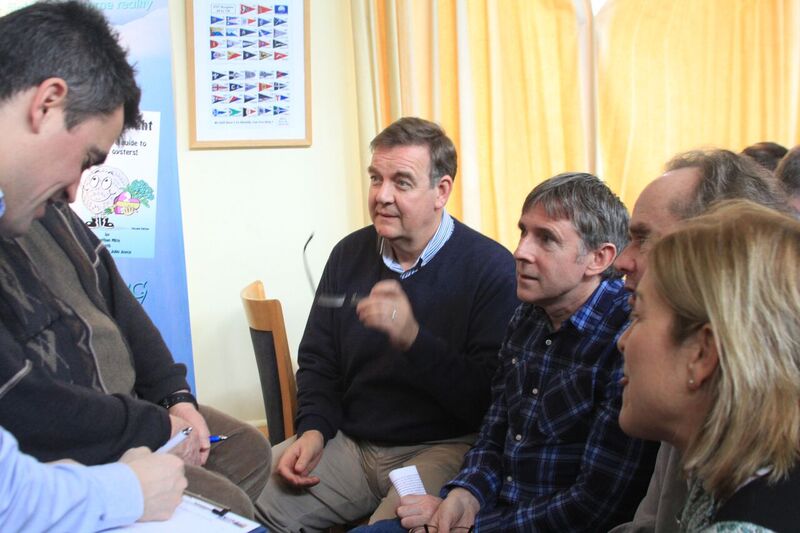
Taking a day off from the general election, RTE News Presenter Brian Dobson was one of 104 cruising and offshore sailors who took part in the ISA Conference. Photo: Alex Blackwell
The whole business of virtually unmarked pot lines all round the Irish coast is becoming such a problem that we’ll probably have a blog completely devoted to it one day. But the good news from Saturday is that the energetic Gary Davis of the HYC Cruising Group has been so determined in his lobbying of politicians and government departments regarding the menace of poorly-marked pot lines that it’s now on the official agenda, which is quite a step forward from the previous apparent indifference.
The conclusions from the break-out groups were to come at the end of the Conference, and provided food for thought with Gary Davis’s news about the new political awareness getting much approval, while there was something of a round of applause for Paddy Judge’s ingenious solution – I omitted to mention he was single-handed at the time of the incident.
The afternoon went promptly into further presentations, with CAI Commodore Clifford Brown putting out the welcome mat for newcomers in a big way. If you wanted to find a catchphrase for the entire conference, “infectious enthusiasm” would be right on target, and Commodore Brown’s exposition, cheerfully outlining the multiple choice in sailing and cruising experience which the CAI members are happy to offer to anyone even slightly interested, was encouraging to behold.
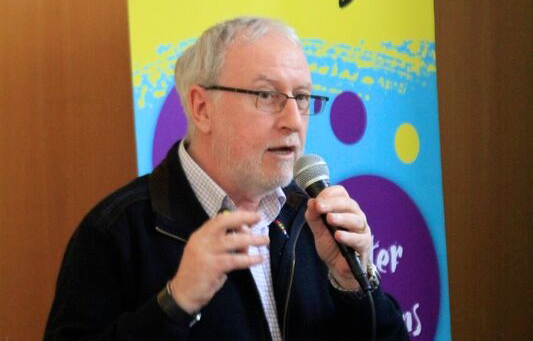
“You’re all welcome, very welcome….” Cruising Association of Ireland Commodore Clifford Brown outlines what his organisation has to offer to experienced sailors and absolute beginners alike. Photo: Alex Blackwell
A star performer. Pat Murphy’s guidance on welcoming and managing new crew drew on his unrivalled experience gained in a nine year round the world cruise. Photo: W M Nixon
However, “inspiring” is the only way to describe the next speaker. Pat Murphy has his top place for ever inscribed in Irish sailing history thanks to his fabulous nine year voyage round the world with his late wife and soulmate Olivia on their fine 40ft cutter Aldebaran. They learned much from it, and as they had guest crews aboard at regular intervals, they learned a great deal more about how to manage and welcome new crew. Pat was hugely generous in imparting nuggets of sound advice and insights culled from an exceptional cruise, and it all combined into a solid body of purest wisdom.
But then came the really serious bit. Chris Reynolds, Director of the Irish Coastguard, took us on an informative tour of his expanding organization, and guided us on the paths to sea safety and the correct course of action in an emergency. These topics had of course come up during the group discussions, where the more senior cruising folk inclined to the view that the joy of cruising is to be found in self-reliance, and if a problem arises you should take pride and satisfaction in solving it yourself, however much the potential or actual risk.

The friendly face of the rescue services – Chris Reynolds is Director of the Irish Coastguard. Photo: Alex Blackwell
But that was appropriate a long time ago, before a proper matrix of rescue and support serves was in place. You just had to be almost totally self-reliant in the old days. Yet nowadays, according to Chris Reynolds, it’s irresponsible to persist in that attitude. His message was simple. If you think you might be getting into trouble, then it’s time to alert the rescue service. For if you know you’re getting into trouble, then it may already be too late to call the rescue services.
This caused some heart-searching among traditionalists, but we hadn’t time to dwell on it, as the next speaker was the force of nature otherwise known as Vera Quinlan of INFOMAR in the Marine Institute in Galway. INFOMAR is the INtegrated Mapping FOr the sustainable development of Ireland’s MARine resource, and Vera Quinlan – a noted ocean cruising sailor in her own right – has been at the heart of it for eight years.
A Force of Nature – Vera Quinlan of INFOMAR. Photo: W M Nixon
If anyone’s interest in the future of the sea had been flagging at this stage, Vera’s enthusiasm soon fired it up again. It’s a whole new world out there, on and under the ocean, when you see it through INFOMAR eyes. And Vera’s vision for Ireland’s maritime future was just the tonic for people who sometimes tend too much to see it as no more than a playground.
The fact that she both works with it, and shows its manifold possibilities for all sorts of sustainable uses, and then goes on to sail across it for pleasure every summer - that was thought-provoking in the extreme. And so too was the concluding item, which had John Leahy, former Commodore of the CAI and a retired airline captain, and Willemien Phelan of Met Eireann in an informal competition to see who had best predicted the weather which would obtain on the day of the conference, using different forecast models in different time spans.
Both had got it pretty much spot on in their predictions a week in advance, but then we were in a spell of routine winter weather with the Great Purple Snake of Atlantis, otherwise known as the Jetstream in high speed mode, weaving across the country with one unpleasantness fairly regularly after another.
“The Great Purple Snake of Atlantis” – Willemien Phelan of Met Eireann with a particularly lurid recent swirling of the Jetstream right across Ireland. Photo: W M Nixon
Since last weekend, as you’ll have noticed the Jetstream took off for two or three days to the sunny south, which consequently wasn’t sunny any more, but Ireland certainly was. However, the Great Snake of Atlantis is due back over us today, but at least you’ll know now why the weather goes to pot when it does.
All this was only part of the wide-ranging presentation given by John and Willemien which showed just how far weather prediction has come on in recent years. The magic Ten Day Forecast may still be out of reach beyond a certain level of accuracy, but they’re closing in on the one week forecast very well indeed these days.
All of which poses a quandary for anyone organising sailing events or planning cruises. For if all the forecasts give the same message, that in a week’s time the weather is going to be plain awful with too much wind for most racing, then you’re faced with the decision of calling it off with plenty of time to spare to enable people to plan other things, or else you just stick to the programme and hope the forecast has been excessively pessimistic.
And on top of that, if several days in advance you do cancel an event whose date was set way back in the winter, when on earth are you going to slot it in later in our current programme, which is jam-packed from one weekend to the next?
But that was only one of many thoughts flying around the Conference last Saturday, and most of them were much more cheerful. The reality is cruising folk just like to get together and talk about boats and cruising until the cows come home, and if a Cruising Conference is organized with a stellar line-up of speakers, it gives it all a sense of extra purpose.
Paddy McGlade, ISA Board Member for Cruising, reviews a successful conference. Photo: W M Nixon
Long after a deservedly happy Paddy McGlade brought this part of the gathering to a conclusion after the draw for the offshore sailing suit donated by Union Chandlery had resulted in a popular win for Terry McCoy of Skerries, people were still contentedly shooting the breeze in the friendly atmosphere of the clubhouse. And the really keen ones were lining themselves up for that night’s annual dinner of the CAI. Cruising people are like that – they’re in for the long haul.

It’s all for Terry! Terry McCoy with Gail MacAllister after the Skerries sailor had won the draw for the sailing suit. Photo: Alex Blackwell
Bam Goes Well In Class, And Lee Overlay Starts To Shift
UPDATE 2200hrs: The RORC Caribbean 600 continues to be a race of swings and roundabouts as different boats come to the fore depending on which part of this multi-island course they’re sailing along writes W M Nixon. There are stages where the only encouragement is in maintaining your class position, and this Wednesday evening at 2200 hrs, Conor Fogerty’s Sunfast 3600 Bam from Howth Yacht Club has the excellent consolation for the Irish squad of leading CSA (Caribbean Sailing Association) Division 2, and holding on to second in IRC Class 3, despite slipping to 24th in the IRC overall rankings.
The big news may well be that Adrian Lee’s reliable steed, the Cookson 50 Lee Overlay Partners, from the Royal St. George Yacht Club, seems finally to have got her skates on, and she was pushing towards 14 knots to be lying 8th overall in IRC – her best placing to date in this year’s race – to have her second in the IRC canting keel division with 57 miles to go to the finish.
The situation is completely different back down the line off Guadeloupe, where Kieran Jameson & Co on the First 40 Southern Child are none too happy at barely 6 knots, and they’re back at 29th overall, though in the kindly CSA 2 they’re lying third in class.
At the top of the leaderboard, the Maxi 72s Proteus (George Sakellaris) and Momo (Diter Schoen) are finished and looking good for IRC first and second overall, but Piet Vroon’s Tonnere 4 is just 24 miles from the finish and could pip Momo yet, though Proteus looks secure.
Meanwhile, spare a thought for Jim and Kristy Clark’s mega maxi Comanche. They went to an awful lot of trouble to get the big fat girl back from the Sydney-Hobart in time to do this race. And for sure, they did take the mono-hull line honours this morning. But their elapsed time was 33 minutes outside the course record set by George David’s Rambler 100 in 2011. That’s the very same Rambler which made an unscheduled visit to Baltimore in August of that year, when her canting keel decided to go walkabout at the Fastnet Rock. 33 minutes. Ouch.
Inaugural Cruising Conference At Howth
The inaugural ISA Cruising Conference at Howth Yacht Club attracted 90 sailors for a very informative day last Saturday.
ISA President David Lovegrove opened proceedings and Keynote speaker Eddie Nicholson and his crew entertained with an excellent show on their adventures to Greenland, with stunning photography, video footage and some eye opening tales of ice movement and local culinary delights. Simon Berrow, of Irish Whale and Dolphin Group and Galway / Mayo Institute of Technology, shared his knowledge of the biodiversity of whales and mammals along our Irish Coastline and gave advise on how leisure boat should approach them and help to ensure their safety.
Sponsorship from Union Chandlery and support from Cruising Association of Ireland helped to made the day a great success, along with the contributions and support from Nicky’s Place on Howth Pier, ICC Publications, Wild Atlantic Way, Met Eireann, INFOMAR, DTTAS, RNLI, Helly Hansen, IWDG, Cool Route & Howth Yacht Club all combined to give every delegate a bag full of fun goodies and useful information.
Experienced offshore sailor and author, Daria Blackwell, made a number of male skippers stop and think, with a talk on Women at the Helm. Many women take on the role of crew on board and never actually helm or rather I should say, skipper. The question that had many male skippers thinking was “If you fell overboard, would your crew be able action a safe ‘man over board?”. Not to mention how much easier it is helm a yacht in to a marina than to be the one jumping off with a line in one hand and a fender in the other. Norman Kean, Fellow of the Royal Institute of Navigation and ICC Publications Editor, gave an excellent explanation of the difference between Vector and Raster Electronic Charts, that left the audience assured that maintaining their knowledge of paper pencil navigation alongside their electronic navigation is always a good idea.
Clifford Brown of the Cruising Association of Ireland brought the room up to date with CAI’s “Crew Together” programme, where the East, West and South coast sailors match crew with boats and give sailors a chance to cruise in each others’ waters. Round the world sailor, Pat Murphy, entertained everyone with his tips on caring for, training and communicating with crew for cruising. In the ethos of the ISA programme of Try Sailing, cruising sailors were encouraged to welcome new crew on board and give them a chance to ‘Try Crewing’.
Vera Quinlan of the INFOMAR project at the Marine Institute, and experienced skipper, had everyone amazed by the detailed information available on the sea bed and the idea of being able to know just where your anchor is landing and what you are sailing over. She had everyone eager to learn more. The final talk on weather could have lasted all day as we all know how important forecasting is for sailing, especially in Irish waters. Willemien Phelan of Met Eireann and Volvo Ocean Race participant, gave a fantastic explanation of weather forecasting with John Leahy, Yachtmaster instructor and pilot.
Fogerty's Bam of Howth Sets Class Pace in Caribbean
Conor Fogerty’s Sunfast 3600 Bam from Howth currently leads IRC 3 in the RORC Caribbean 600 which started today off Antigua, with the international fleet of 77 boats taking off around eleven islands in the sun in classic conditions writes W M Nixon at 2200 hrs Monday.
Overall however, Bam – pushing towards 9 knots with the first turn at Barbuda astern – lies 20th in a fleet in which the current IRC leader is Piet Vroons’ Ker 51 Tonnere 4, having taken over the IRC front runner slot from Dieter Schoen’s Maxi 72 Momo, fresh into the Caribbean as the best big boat in the 2015 Fastnet. She is second on IRC Overall, and is currently racing just ahead of Hap Fauth’s Maxi 72 Bella Mente with another 72 Jethou (Peter Ogden) lying third.
Of the other two Irish boats, Adrian Lee’s Cookson 50 Lee Overlay partners currently heads Bam overall, as the Dun Laoghaire boat is 15th in fleet, while Kieran Jameson and his team on the First 40 Southern Child are placed 33rd overall.
At the front end of the fleet and already in a world of their own are the MOD 70 trimarans, with Lloyd Thornburg’s Phaedo showing the way by three miles on Ned Collier Wakefield’s Concise 10, both of them sitting on better than 20 knots.
HYC's Brian Turvey on board Southern Child (GBR 8405) adds:
Following 3 days of 'climatisation' in the wonderful hot weather and warm hospitality of Antigua, the crew of Southern Child finally set out and hit the start line at 11:00 on Monday morning. The race was started in a 15-knot East-Southeasterly breeze, providing the 70 competitors with a long starboard fetch along the southern coastline before the usual bear-away and northward track to the Barbuda mark.
With no air conditioning on this First 40 and a lot of sweaty Irishmen oozing the excesses of Caribbean revelry, the following breeze on the track northwards offered welcome air in the cabin once the watch-system commenced at 2pm. A 2-hour 'conditioning watch' allowed the split teams to get used to the systems in the afternoon, followed by a transition to 3-hour watches at 6pm.
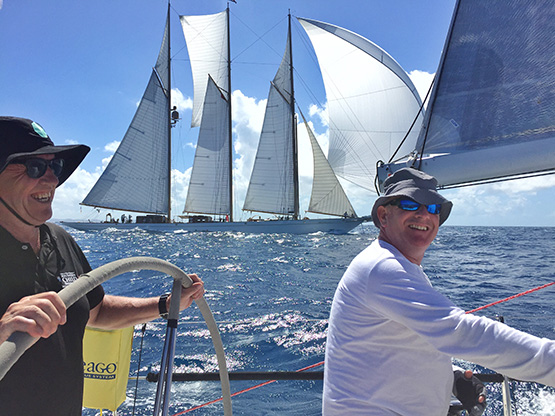
The 215–foot 'Adix' pictured to leeward of HYC helm Colm 'Bermo' Bermingham and Frank 'Buller' Dillon on Southern Child
It was clear from the beginning that Frank 'Buller' Dillon was the most chilled-out member of the team and even when confronted with the news that the ice had run out at the welcoming party in Antigua Yacht Club, he rationalised that "the rum was purer!" Whilst still somewhat of a mystery in terms of its origin, Frank's nickname ('Buller') belies his relaxed demeanour in these latitudes and he was one of the many Irish sailors who enjoyed the warm greeting on the welcome night in AYC, including a special 'Cead mile failte' (Irish for 'one hundred thousand welcomes') given to them by RORC Commodore Micheal Boyd from the outdoor stage and to a tumoultous cheer.
With the exception of owner Lucy Reynolds, all of the crew of Southern Child are members of Howth Yacht Club in Ireland and form part of a 2-boat team with 'Bam', the other Howth entry a division below in Class 3.
Southern Child was steered past St Kitts and St Nevis late on Monday night by crew member Colm 'Bermo' Bermingham under the brilliant light of a Caribbean full moon, completing the first day of racing and within 500 metres of almost all boats in IRC Class 2. The night time temperature barely dropped to 26 degrees Celcius and with an 18-knot wind pushing us through schools of small dolphins in the very warm moonlit Eastern Caribbean Sea, might it be possible that it might continue like this...?
Irish Sailors Up For It In RORC Caribbean 600
For those reared in the simple certainties of the course in the offshore classics like the Rolex Fastnet Race and the even more clearly defined Volvo Round Ireland Race, the multi-island RORC Caribbean 600 which starts tomorrow (Monday) morning at Antigua is a strange beast writes W M Nixon.
Set against the straight-line austerity of other long-established classics such as the Newport-Bermuda and the Rolex Sydney-Hobart, its weaving course makes it seem almost fussy. But in a typical February in the Northern Hemisphere, people will happily race round as many islands as are required to make the magic 600 miles total. Just so long as it’s in those marvellous Caribbean sailing and climatic conditions which contrast so totally with what many other areas of the Northern Hemisphere are experiencing in this dank dark cold month.

It’s a busy course – with so many islands to be ticked off, navigators could usefully employ the services of a continuity director…
Eleven islands are required to act as race marks in order to put sufficient mileage in the course. But with 77 boats – many of them noted superstars – tuned up and ready to go, it’s clear that the huge variety of legs both long and short which have to be sailed is no deterrent, and Irish interest is high both in terms of participation, and in the presence of international contenders expected for the Volvo Round Ireland Race in June.
Then too we’ve a certain proprietorial interest. The Caribbean 600 having been inaugurated as recently as 2009, it’s a modern classic. And the fact that on its first staging, it was won overall by Adrian Lee’s Cookson 50 Lee Overlay Partners from Dun Laoghaire, makes it extra special. For in her previous life as Ger O’Rourke’s Chieftain, the Lee ship had been overall winner in the Rolex Fastnet Race 2007, providing the rare if not unique situation that the same Irish boat won two classics in the space of just 18 months.
Six years later, the ever-green Cookson 50 is such a good all-rounder that she’s still very much in the hunt, and Lee Overlay Partners is in the listings for tomorrow’s start, the smallest boat in the six strong canting-keel division which includes such giants as Jim and Kristy Hinze Clark’s mega-powerful hundred footer Comanche.
We’ve interest throughout the race, as in addition to Lee Overlay Partners, the fleet includes two Howth Yacht Club crews. Howth sailors with the likes of Kieran Jameson on the strength have already got involved in past seasons in the Rolex Middle Sea Race with a Performance Yacht Charter’s First 40, and now with two of PWC’s boats of this proven marque on the other side of the Atlantic, there with PYC’s Lucy Johnson on Southern Child are Howth men raring to go Caribbean island-rounding. Much of the Howth team assembled by Darren Wright for the 2014 Rolex Middle Sea Race are re-joining the same boat, Southern Child, and their lineup incudes Kieran Jameson, Frank Dillon, Rick de Neve, Jonny White, Colm Bermingham, while new talent in the form of Michael Wright, recently-retired HYC Commodore Brian Turvey, and young Howth K25 squad member Luke Malcolm are also on the strength.
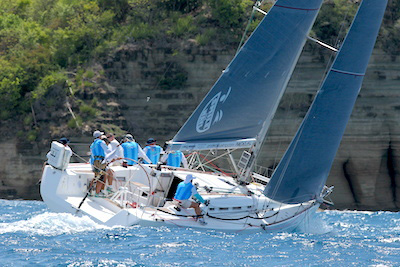
One of the two Howth crews will be racing the First 40 Southern Child, which they’ve already campaigned in the Rolex Middle Sea Race
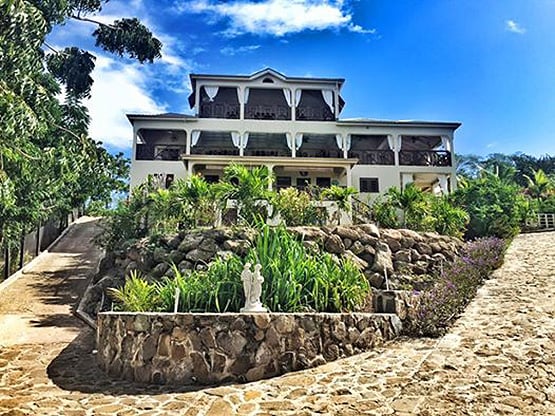
Howth Yacht Club Headquarters for the RORC 600: Villa Touloulou
Up against them to provide a spot of in-club competition is HYC’s Conor Fogerty who is doing an Atlantic circuit as a mix of racing and cruising with his new Sunfast 3600 Bam, a boat which might have been designed with RORC Caribbean 600 enjoyment in mind. Bam’s racing crew coming out from home include Simon Knowles, Daragh Heagney, Paddy Gregory, Roger Smith and Anthony Doyle. After Bam sister-ship Red Shift’s success in last year’s race, Conor Fogerty has great hopes for his stylish boats showing once tomorrow has seen the start – usually a very challenging business in itself – get cleanly away.
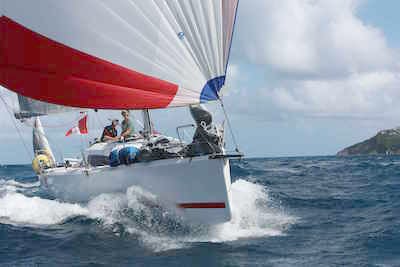
Conor Fogerty’s Sunfast 36 Bam from Howth is doing the RORC Caribbean 600 as part of an Atlantic odyysey
Ireland’s own RORC Commodore Michael Boyd of the RIYC, who won the Gull Salver for best-placed Irish boat in last year’s Fastnet Race with the Grand Soleil 43 Quokka 8, is helping to pass the time while waiting for delivery of his new JPK 10.80 by racing the Caribbean as navigator on Andy McIrvine’s Grand Soleil 46 Bella Donna.
As for pointers towards the Volvo Round Ireland Race in June, the two MOD 70 trimarans already signed up for it, Lloyd Thornburg’s Phaedo 3 and Concise 10 (Tony Lawson & Ned Collier Waefield) are both g0ing for the Caribbean 600.

Lloyd Thornburg’s MOD 70 Phaedo 3 is one of two sister-ships entered for the Volvo Round Ireland Race 2016 which are also doing the Caribbean 600, the other being Concise 10.
In fact it’s a very eclectic fleet, as Eric de Turckheim’s noted Commodore’s Cup contender of 2014, Teasing Machine from France, has somehow got herself to the Caribbean after being far away to cut a successful swathe through the recent Rolex Sydney-Hobart Race. And up towards the top of the fleet, the 72ft mini-maxi Momo, which was best of the bigger boats in last summer’s Fastnet, find herself up against Hap Fauth’s similarly-sized superstar Bella Mente, which had to scratch from the 2015 Fastnet Race for personal reasons after a blisteringly successful Cowes Week, but is now set to go in a race in which she is the defending champion.

Back to the fray. Having been forced to scratch from the Rolex Fastnet 2015 in which she was a favourite, Hap Fauth’s 72ft mini-maxi Bella Mente is very much in the hunt in tomorrow morning’s RORC Caribbean 600, in which she is defending champion.
The 72ft mini-maxis seem to be the favoured size of boat o the most recent peformances, as Nik Zennstrom’s Ran won in 2012, George Sakellaris’s Shockwave won in 2014, and Bella Mente won in 2015. But the evergreen Cookson 50 is a good steady bet, with Lee Overlay Partners; win in 2009, and Ron O’Hanley’s with Privateer in 2013.
The RORC Caribbean 600 starting process gets under way at 1030hrs local time tomorrow morning off Antigua, and there are going to be 77 very busy crews having more than a few dry-mouth moments before they get clear away around this island’s beautiful east coast.
Irish Cruising Comes Centre Stage In Howth Yacht Club
With last night’s Irish Cruising Club Annual General Meeting & Prize-Giving hosted at Howth Yacht Club, and this morning’s day-long ISA Cruising Conference at the same venue, centre stage has been taken by the silent majority – the large but distinctly reticent segment of the sailing population which emphatically does not have racing as its primary interest afloat. W M Nixon takes us on a guided tour.
The great Leif Eriksson would approve of some of the more adventurous members of the Irish Cruising Club. They seem to be obsessed with sailing to Greenland and cruising along its coast. And it was the doughty Viking’s father Erik Thorvaldsson (aka Erik the Red) who first told his fellow Icelanders that he’d given the name of Greenland to the enormous island he’d discovered far to the west of Iceland. He did so because he claimed much of it was so lush and fertile, with huge potential for rural and coastal development, that no other name would do.
Leif then followed in the family tradition of going completely over the top in naming newly-discovered real estate. He went even further west and discovered a foggy cold part of the American mainland which he promptly named Vinland, as he claimed the area was just one potential classic wine chateau after another, and hadn’t he brought back the vines to prove it?
In time, Erik’s enthusiasm for Greenland was seen as an early property scam. For no sooner had the Icelanders established a little settlement there around 1000 AD than a period of Arctic cooling began to set in, and by the mid-1300s there’d been a serious deterioration of the climate. What had been a Scandinavian population of maybe five thousands at its peak faded away, and gradually the Inuit people – originally from the American mainland – moved south from their first beachheads established to the northwest around 1200 AD. They proved more successful at adapting to what had become a Little Ice Age, while no Vikings were left.
Now we’re in the era of global warming, and there’s no doubt that Greenland is more accessible. But for those of us who think that cruising should be a matter of making yourself as comfortable as possible while your boats sails briskly across the sea in a temperate climate or perhaps even warmer for preference, the notion of devoting a summer to sailing to Greenland and taking on the challenge of its rugged iron coast, with ice everywhere, still takes a bit of getting used to.
Yet in recent years the Irish boats seem to have been tripping over each other up there. And for some true aficionados, the lure of the icy regions was in place long before the effects of global warming were visibly making it more accessible.
Peter Killen of Malahide, Commodore of the Irish Cruising Club, is a flag officer who leads by example. It was all of twenty years ago that he was first in Greenland with his Sigma 36 Black Pepper, and truly there was a lot of ice about. The weather was also dreadful, while Ireland was enjoying the best summer in years.

Peter Killen’s Sigma 36 Black Pepper in local ice at the quay inside Cape Farewell in Greenland, August 1995

ICC Commodore Peter Killen’s current boat is Pure Magic, an Amel Super Maramu seen here providing the backdrop for a fine penguin in Antarctica, December 2004.
More recently, he and his crew of longterm shipmates have been covering thousands of sea miles in the Amel Super Maramu 54 Pure Magic, among other ventures having a look at lots more ice down Antarctic way to see how it compares with the Arctic. With all their wanderings, by the end of the 2014 season Pure Magic was laid up for the winter in eastern Canada in Nova Scotia. So of course in order to get back to Ireland through 2015, the only way was with a long diversion up the west coast of Greenland. And the weather was grand, while Ireland definitely wasn’t enjoying the best summer in years.
The Pure Magic team certainly believe in enjoying their cruising, however rugged the terrain. If the Greenland Tourist Board are looking for a marketing manager, they could do no better than sign up the skipper of Pure Magic for the job. His entertaining log about cruising the region – featured in the usual impressive ICC Annual edited for the fourth time by Ed Wheeler – makes West Greenland seem a fun place with heaps of hospitality and friendly folk from one end to the other.

If ice is your thing, then this is the place to be – Peter Killen’s Pure Magic off the west Greenland coast, summer 2015.
But then Peter Killen is not as other men. I don’t mean he is some sort of alien being from the planet Zog. Or at least he isn’t so far as I know. But the fact is, he just doesn’t seem to feel the cold. I sailed with him on a raw Autumn day some years ago, and while the rest of us were piling on the layers, our skipper was as happy as Larry in a short-sleeved shirt.
I’d been thinking my memory had exaggerated this immunity to cold. But there sure enough in the latest ICC Annual is a photo of the crew of Pure Magic enjoying a visit to the little Katersugaasivik Museum in Nuuk, and the bould skipper is in what could well be the same skimpy outfit he was wearing when we sailed together all those years ago. As for the rest of the group, only tough nut Hugh Barry isn’t wearing a jacket of some sort – even Aqqala the Museum curator is wearing one.
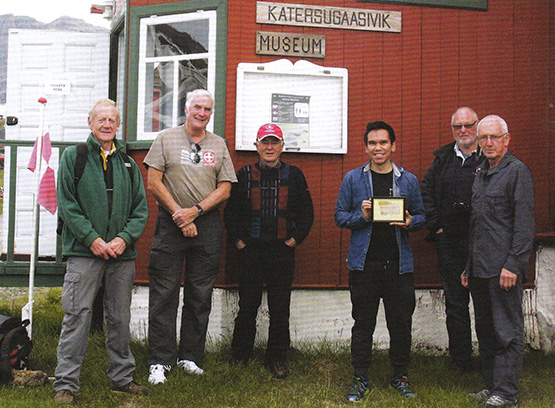
Some folk feel the cold more than others – Pure Magic’s crew absorbing local culture in Greenland are (left to right) Mike Alexander, Peter Killen, Hugh Barry, Aqqalu the museum curator, Robert Barker, and Joe Phelan
Having a skipper with this immunity to cold proved to be a Godsend before they left Greenland waters, when Pure Magic picked up a fishing net in her prop while motoring in a calm. Peter Killen has carried a wetsuit for emergencies for years, and finally it was used. He hauled it on, plunged in with breathing gear in action, and had the foul-up cleared in twenty minutes. Other skipper and Commodores please note……
The adjudicator for the 2015 logs was Hilary Keatinge, who has one of those choice-of-gender names which might confuse, so it’s good news to reveal that after 85 years, the ICC has had its first woman adjudicator. No better one for the job, man or woman. Before marrying the late Bill Keatinge, she was Hilary Roche, daughter of Terry Roche of Dun Laoghaire who cruised the entire coastline of Europe in a twenty year odyssey of successive summers, and his daughter has proven herself a formidable cruising person, a noted narrator of cruising experiences, and a successful writer of cruising guides and histories.
Nevertheless even she admitted last night that once all the material has arrived on the adjudicator’s screen, she finally appreciated the enormity of the task at hand, for the Irish Cruising Club just seems to go from strength to strength. Yet although it’s a club which limits itself to 550 members as anything beyond that would result in administrative overload and the lowering of standards, it ensures that the experience of its members benefit the entire sailing community through its regularly up-dated sailing directions for the entire coast of Ireland. And there’s overlap with the wider membership of the Cruising Association of Ireland, which will add extra talent to the expert lineup providing a host of information and guidance at today’s ISA Cruising Conference.
But that’s this morning’s work. Meanwhile last night’s dispensation of the silverware – some of which dates back to 1931 – revealed an extraordinarily active membership. And while they did have those hardy souls who ventured into icy regions, there were many others who went to places where the only ice within thousands of miles was in the nearest fridge, and instead of bare rocky mountains they cruised lush green coasts.
Nevertheless the ice men have it in terms of some of the top awards, as Hilary Keatinge has given the Atlantic Trophy for the best cruise with a passage of more than a thousand miles to the 4194 mile cruise of Peter Killen’s Pure Magic from Halifax to Nova Scotia to Howth, with those many diversions on the way, while the Strangford Cup for an alternative best cruise goes to Paddy Barry, who set forth from Poolbeg in the heart of Dublin Port, and by the time he’d returned he’d completed his “North Atlantic Crescent”, first to the Faeroes, then Iceland to port, then across the Denmark Strait to southeast Greenland for detailed cruising and mountaineering, then eventually towards Ireland but leaving Iceland to port, so they circumnavigated it in the midst of greater enterprises.
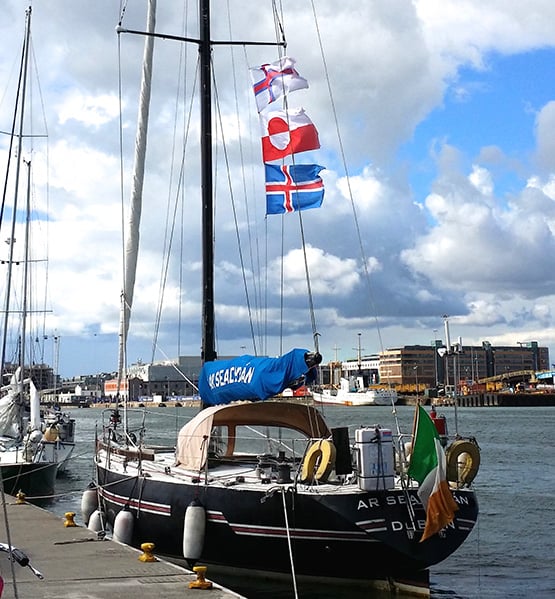
You collect very few courtesy ensigns in the frozen north. Back at Poolbeg in Dublin after her “North Atlantic Crescent” round Iceland and on to Greenland, Paddy Barry’s Ar Seachran sports the flags of the Faroes, Iceland and Greenland. Ar Seachran is a 1979 alloy-built Frers 45. Photo: Tony Brown
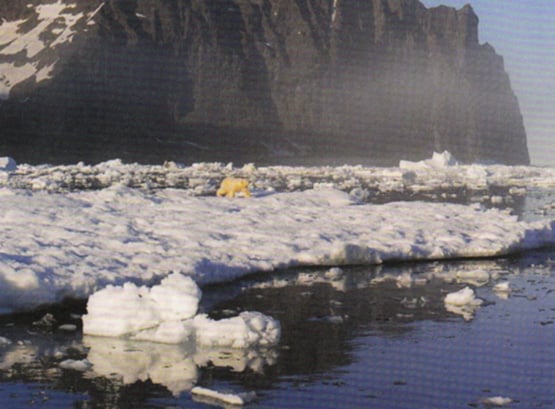
“Definitely the Arctic”. A polar bear spotted from Ar Seachran. Photo: Ronan O Caoimh
Paddy Barry started his epic ocean voyaging many years ago with the Galway Hooker St Patrick, but his cruising boat these days is very different, a classic Frers 45 offshore racer of 1979 vintage. Probably the last thing the Frers team were thinking when they turned out a whole range of these gorgeous performance boats thirty-five years ago was that their aluminium hulls would prove ideal for getting quickly to icy regions, and then coping with sea ice of all shapes and ices once they got there. But not only does Paddy Barry’s Ar Seacrhran do it with aplomb, so too does Jamie Young’s slightly larger sister, the Frers 49 Killary Flyer (ex Hesperia ex Noryema XI) from Connacht, whose later adventures in West Greenland featured recently in a TG4 documentary.
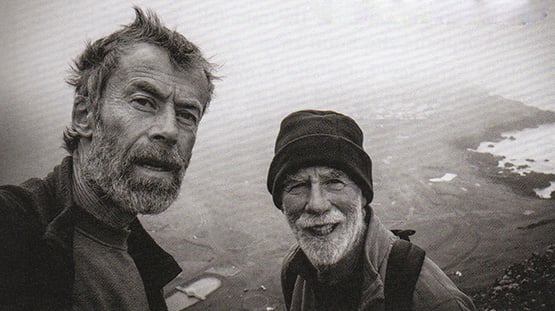
“A grand soft day in Iceland”. Harry Connolly and Paddy Barry setting out to take on mountains in Iceland during their award-winning cruise to Greenland. Photo: Harry Connolly
Pure Magic and Ar Seachran are hefty big boats, but the other ICC voyager rewarded last night by Hilary Keatinge for getting to Arctic waters did his cruise in the Lady Kate, a boat so ordinary you’d scarcely notice her were it not for the fact that she’s kept in exceptionally good trim.
Drive along in summer past the inner harbour at Dungarvan in West Waterford at low water, and you’ll inevitably be distracted by the number of locally-based bilge-keelers sitting serenely upright (more or less) on that famous Dungarvan mud. There amongst them might be the Moody 31 Lady Kate, for Dungarvan is her home port.
But she was away for quite a while last year, as Donal Walsh took her on an extraordinary cruise to the Arctic, going west of the British mainland then on via Orkney and Shetland to Norway whose coast goes on for ever until you reach the Artic Circle where the doughty Donal had a swim, as one does, and looked at a glacier or too, and then sailed home but this this time leaving the British mainland to starboard. A fabulous 3,500 mile eleven week cruise, he very deservedly was awarded the Fingal Cup for a venture the adjudicator reckons to be extra special – as she puts it, “you feel you’re part of the crew, though I don’t think I’d have done the Arctic Circle swim.”
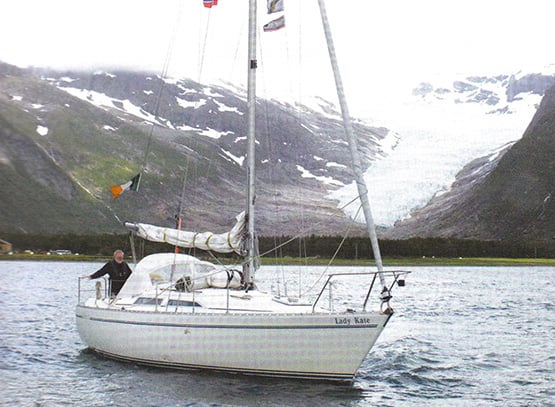
A long way from Dungarvan. Lady Kate with Donal Walsh off the Svartsen Glacier in northern Norway
Indeed, in taking an overview of the placings of the awards, you can reasonable conclude that the adjudicator reckons any civilized person can have enough of ice cruising, as she gives the ICC’s premier trophy, the Faulkner Cup, to a classic Atlantic triangle cruise to the Azores made from Dun Laoghaire by Alan Rountree with his van de Sadt-designed Legend 34 Tallulah, a boat of 1987 vintage which he completed himself (to a very high standard) from a hull made in Dublin by BJ Marine.
Tallulah looks as immaculate as ever, as we all saw at the Cruising Association of Ireland rally in Dublin’s River Liffey in September. And this is something of a special year for Alan Rountree, as completely independently of the Faulkner Cup award, the East Coast ICC members awarded their own area trophy, the Donegan Cup for longterm achievement, to Tallulah’s skipper. As one of those involved in the decision put it, basically he got the Donegan Trophy “for being Alan Rountree – what more can be said?”
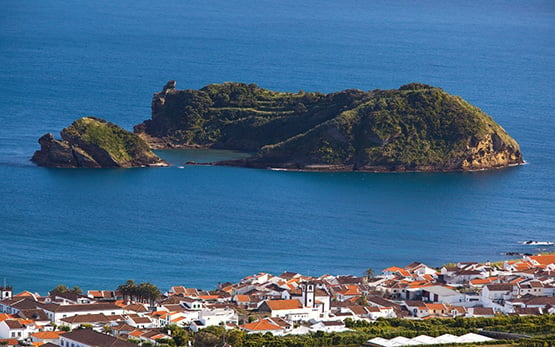
The essence of the Azores. Red roofs maybe, but not an iceberg in sight, and the green is even greener than Ireland. Alan Rountree’s succesful return cruise to the Azores has been awarded the ICC’s premier trophy, the Faulkner Cup.

Tallulah at the CAI Rally in the Liffey last Setpember. She looks as good today as when Alan Rountree completed her from a bare hull nearly thirty years ago. Photo: W M Nixon
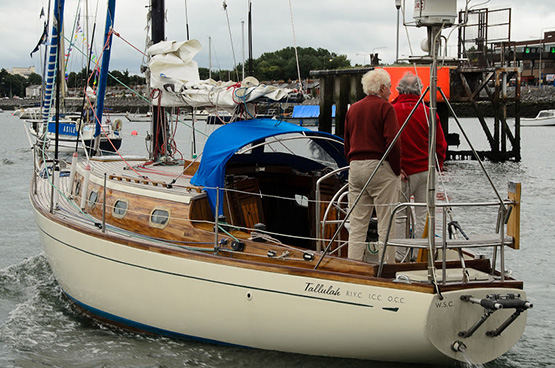
A boat to get you there – and back again. Tallulah takes her departure from the CAI Rally in Dublin. Photo: Aidan Coughlan
Well, it can be said that his Azores cruise was quietly courageous, for although the weather was fine in the islands, the nearer he got to Ireland the more unsettled it became, and he sailed with the recollection of Tallulah being rolled through 360 degrees as she crossed the Continental Shelf in a storm in 1991. But he simply plodded on through calm and storm, the job was done, and Tallulah is the latest recipient of a trophy which embodies the history of modern Irish cruising.
There were many other awards distributed last night, and for those who think that the ICC is all about enormous expensively-equipped boats, let it be recorded that the Marie Trophy for a best cruise in a boat under 30ft long went to Conor O’Byrne of Galway who sailed to the Hebrides with his Sadler 26 Calico Jack, while the Fortnight Cup was taken by a 32-footer, Harry Whelehan’s Jeanneau Sun Odyssey 32 for a fascinating cruise in detail round the Irish Sea, an area in which, the further east you get to coastlines known to very few Irish cruising men, then the bigger the tides become with very demanding challenges in the pilotage stales.
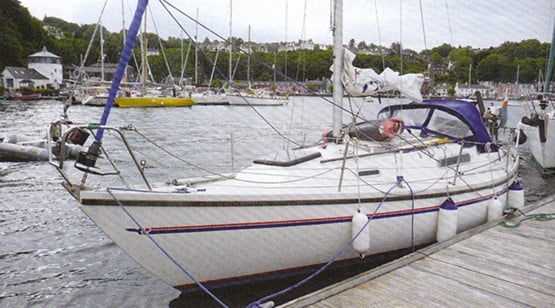
The smallest boat to be awarded a trophy at last night's Irish Cruising Club prize-giving was Conor O’Byrne’s Sadler 26 Calico Jack, seen here in Tobermory during her cruise from Connacht to the Hebrides
As for “expensively equipped”, the Rockabill Trophy for seamanship went to Paul Cooper, former Commodore of Clontarf Yacht & Boat Club and an ICC member for 32 years, who solved a series of very threatening problems with guts and ingenuity aboard someone else’s Spray replica during a 1500 mile voyage in the Caribbean, with very major problems being skillfully solved, as the judge observed, “without a cross word being spoken”.
Not surprisingly in view of the weather Ireland experienced for much of the season, there were no contenders for the Round Ireland cruise trophy, though I suppose you could argue that the return of Pure Magic meant the completion of a round Ireland venture, even if in this case the Emerald Isle becomes no more than a mark of the course.
In fact, with the unsettled weather conditions of recent summers in Ireland , there’s now quite a substantial group of ICC boats based out in Galicia in northwest Spain, where the mood of the coast and the weather “is like Ireland only better”. The ICC Annual gives us a glimpse of the activities of these exiles, and one of the most interesting photos in it is provided by Peter Haden of Ballyvaughan in County Clare, whose 36ft Westerly Seahawk Papageno has been based among the Galician rias for many years now.
Down there, the Irish cruising colony can even do a spot of racing provided it’s against interesting local tradtional boats, and Peter’s photo is of Dermod Lovett of Cork going flat out in his classic Salar 40 Lonehort against one of the local Dorna Xeiteras, which we’re told is the Galician equivalent of a Galway Bay gleoiteog. Whatever, neither boat in the photo is giving an inch.
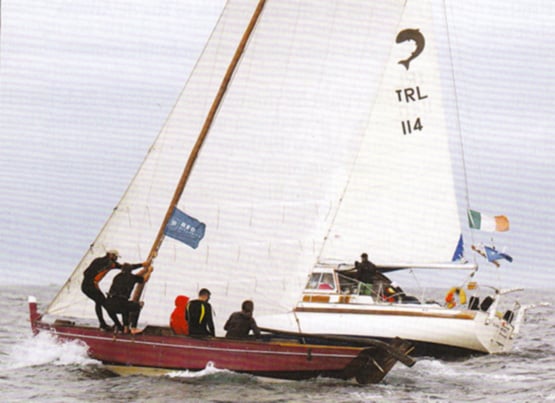
So who never races? Dermod Lovett ICC in competition with his Salar 40 Lonehort against a local traditional Dorna Xeiteira among the rias of northwest Spain. Photo: Peter Haden
Hilary Keatinge’s adjudication is a delight to read in itself, and last night after just about every sailing centre in Ireland was honoured with an ICC award for one of its locally-based members, naturally the crews leapt to the mainbrace and great was the splicing thereof.
But it’s back to porridge this morning in HYC and the serious work of the ISA Cruising Conference, where the range of topics is clearly of great interest, for the Conference was booked out within a very short time of being highlighted on the Afloat.ie website.
It’s during it that we’ll hear more about that intriguing little anchorage which provides our header photo, for although it could well be somewhere on the Algarve in Portugal, or even in the Ionian islands in Greece were it not for the evidence of tide, it is in fact on the Copper Coast of south Waterford, between Dungarvan and Dunmore East, and it’s known as Blind Harbour.
It’s a charming place if you’ve very settled weather, but it’s so small that you’d probably need to moor bow and stern if you were thinking to overnight, but that’s not really recommended anyway. Norman Kean, Editor of the Irish Cruising Club Sailing Directions, had heard about this intriguing little spot from Donal Walsh of Dungarvan (he who has just been awarded the Fingal Cup), and being Norman Kean, he and Geraldine just had to go and experience it for themselves. But it has taken three attempts to have the right conditions as they were sailing by, and it happened in 2015 in a very brief period of settled weather as they headed past in their recently-acquired Warrior 40 Coire Uisge, which has become the new flagship of the ICC’s informal survey flotilla.

The secret cove is to be found on Waterford’s Copper Coast, midway between Dungarvan and Dunmore East. Courtesy ICC
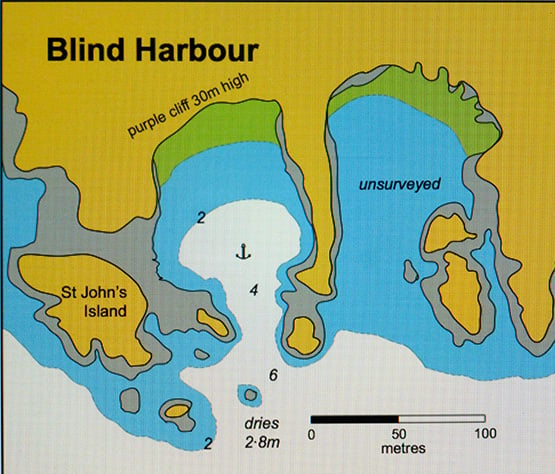
The newly-surveyed Blind Harbour on the Waterford coast as it appears in the latest edition of the ICC’s South & West Coasts Sailing Directions published this month. Courtesy ICC.
They found they’d to eye-ball their way in to this particular Blind Harbour (there are others so-named around the Irish coast) using the echo sounder, as any reliance on electronic chart assistance would have had them on the nearest part of County Waterford, albeit by only a matter of feet. With a similar exercise a couple of years ago, they found that the same thing was the case at the Joyce Sound Pass inside Slyne head in Connemara – rely in the chart plotter, and you’re making the pilotage into “impactive navigation”.
The message is that some parts of charts are still relying on surveys from a very long time ago, and locations of hyper-narrow channels may be a few metres away from where they actually are. On the other hand, electronic anomalies may arise. Whatever the reason, I know that a couple of years ago, in testing the ship’s gallant little chart plotter we headed for the tricky-enough Gillet passage inside the South Briggs at the south side of the entrance to Belfast Lough, and found that it indicated the rocks as shown were a tiny bit further north than we were seeing, which could have caused a but of a bump if we’d continued on our electronic way.
Electronic charts are only one of many topics which will be covered today. We hope to bring a full report next Saturday, for the participants will in turn require a day or two to digest their findings.




























